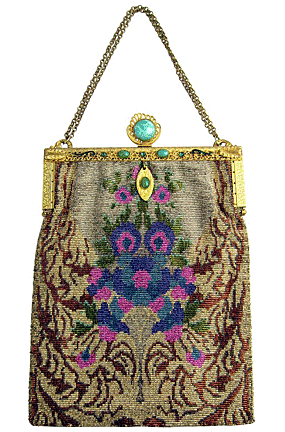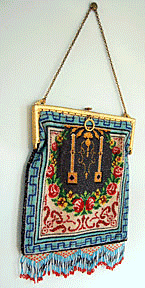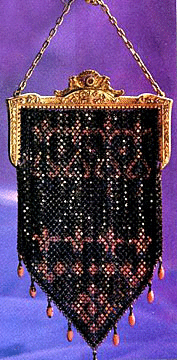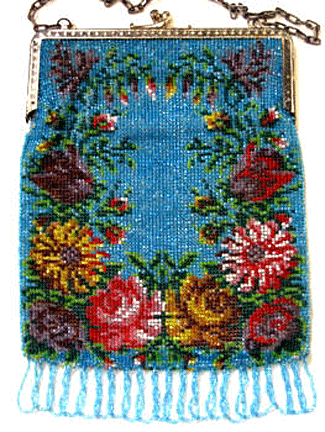|
The Little Beaded Bag
________________________________________________________
 QUESTION: QUESTION:
I recently purchased a little beaded
bag at an antique show. It’s so delicate and finely done. Can you tell
me how I might figure out how old it is and perhaps something about
beaded bags in general?
Thanks,
Jane
______________________________________________________
ANSWER:
 After
years of languishing in attic trunks and flea markets, antique beaded
bags have become among the most sought after collectibles. This has
caused prices, and thus value to soar in recent years. After
years of languishing in attic trunks and flea markets, antique beaded
bags have become among the most sought after collectibles. This has
caused prices, and thus value to soar in recent years.
Until the 16th century, women wore purses dangling from the waist. By
the 17th century, flat tapestry or embroidered wallets were common. But
by the late 18th century, the hand-carried framed or drawstring purse or
handbag had appeared. Especially prized were French sable beaded bags
made of beads so tiny it took about 1,000 to make a square inch. Designs
included commemorative scenes like the first balloon flight in 1783.
 In
the early 19th century, women began carrying their
indispensables—handkerchief, fan, perfume bottle—in little drawstring
bags made of fabric. Often elaborately trimmed with beads or lace, they
called them "reticules." So popular was the reticule that it became an
absolute "must" for fashionable ladies of the 19th century. In
the early 19th century, women began carrying their
indispensables—handkerchief, fan, perfume bottle—in little drawstring
bags made of fabric. Often elaborately trimmed with beads or lace, they
called them "reticules." So popular was the reticule that it became an
absolute "must" for fashionable ladies of the 19th century.
Between 1820 and 1830, beaded bags supported by metal frames came into
vogue. Coming primarily from France and Austria, the frames were made of
everything from pinchbeck, an alloy of cooper and zinc made to look like
gold, to tortoiseshell. Makers attached chains, often formed of
decorative, ornate links, to the frames.
 Floral
beaded purses flourished from the mid to late 1800s. At that time,
milliners, perfumers, and trinket shops sold beaded purses,, but
Victorian ladies, who prided themselves on their fancywork, often made
their own from patterns found in Godey's Lady's Book and other fashion
publications. They particularly favored floral designs of tulips, roses,
lilies, and forget-me-nots in bouquets or strewn across a solid
background of beads. Only the most experienced beaders attempted
intricate landscape, Biblical, and figurative motifs. The finer the
beads used, the more tapestry-like the appearance. Floral
beaded purses flourished from the mid to late 1800s. At that time,
milliners, perfumers, and trinket shops sold beaded purses,, but
Victorian ladies, who prided themselves on their fancywork, often made
their own from patterns found in Godey's Lady's Book and other fashion
publications. They particularly favored floral designs of tulips, roses,
lilies, and forget-me-nots in bouquets or strewn across a solid
background of beads. Only the most experienced beaders attempted
intricate landscape, Biblical, and figurative motifs. The finer the
beads used, the more tapestry-like the appearance.
By the early 20th century, beaded bags had become increasingly
fashionable. Frames were more ornate, often made of solid gold, sterling
silver, nickel, amber, ivory, or celluloid and often heavily engraved or
embossed, embellished with gemstones, filigree, pearls or enamel work.
The criteria for judging a purse's value include condition, rarity, bead
size, complexity of pattern, and the uniqueness of the frame. Some of
these frames are remarkably detailed works on their own, ornately
executed in silver, wrought gold, or brass, and inset with tiny stones
and pearls. Each bag has its own personality Some are very regal and
elegant while others are more simple, homespun items.

Dating a beaded bag can be a challenge since newer bags are often made
with older beads. For instance, beads from the early 19th century might
be used to decorate bags made in the 1920s. And while a bag's frame can
sometimes provide clues to its age, not even this is foolproof.
<
Back to Readers Ask Archives Next
Article >
|
